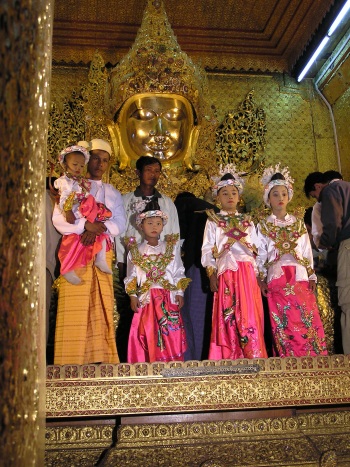The Mahamuni is one of the most revered and significant Buddhist sites in Myanmar. It refers to the Mahamuni Pagoda and its famous Mahamuni Buddha image, which is considered one of the most sacred and important Buddha statues in the country.
Key Facts about the Mahamuni and the Mahamuni Buddha:
-
Mahamuni Pagoda:
- Located in Mandalay, the second-largest city in Myanmar, the Mahamuni Pagoda is one of the most visited and spiritually significant temples in the country.
- The pagoda is dedicated to the Mahamuni Buddha, which is enshrined within it. The pagoda complex is a major pilgrimage site for Buddhists and is associated with the Theravada Buddhist tradition.
-
Mahamuni Buddha Image:
- The Mahamuni Buddha is a highly revered Buddha statue that is said to be one of the five likenesses of the Buddha that were created during his lifetime. According to tradition, it is believed to be an authentic representation of the Buddha’s appearance during his time on earth.
- The statue is made of bronze and is coated with layers of gold leaf, which have been applied by devotees over many centuries. The golden patina on the statue is a result of the numerous layers of gold leaf left by those who visit to honor the Buddha.
- The Buddha is depicted in a meditative seated posture, with downcast eyes and a serene expression, which is a common feature in Buddhist iconography.
-
Historical Significance:
- The Mahamuni Buddha is believed to have been brought to Myanmar from India during the reign of King Bodawpaya in the 18th century. According to legend, the statue was originally located in Dharmarajya, a city in India, and was later brought to Mandalay by the king as part of his efforts to establish and propagate Buddhism in his kingdom.
- The statue has become a symbol of Myanmar’s devotion to Buddhism, and it is considered a powerful source of spiritual merit. Pilgrims from all over Myanmar and abroad visit the pagoda to pay homage to the Mahamuni Buddha.
-
Rituals and Practices:
- One of the key practices at the Mahamuni Pagoda is the daily ritual of washing the Buddha’s face. Every morning, a group of monks and devotees gather to wash the face of the Mahamuni Buddha with water and sandalwood paste, which is believed to purify the statue and generate spiritual merit for the practitioners.
- Visitors to the pagoda can also participate in the tradition of offering gold leaf to the Buddha statue, further adding to the layers of gold that cover it. This act is seen as a form of devotional offering and a way to gain spiritual merit.
- There are also prayer halls and shrines in the surrounding area where people can pray and meditate.
-
Cultural and Religious Importance:
- The Mahamuni Pagoda and its Buddha statue are an essential part of Myanmar’s cultural and religious heritage. The pagoda is not only a place of worship but also a significant symbol of Buddhist devotion and Myanmar’s deep-rooted spirituality.
- It is a pilgrimage site for both Burmese Buddhists and international visitors who come to witness the religious practices and to pay respects to the sacred Buddha image.
In conclusion, the Mahamuni Buddha and its pagoda are among the most significant religious landmarks in Myanmar, playing a crucial role in the country's spiritual life. The traditions and rituals surrounding the Mahamuni Pagoda make it an integral part of Myanmar’s cultural and religious identity.





